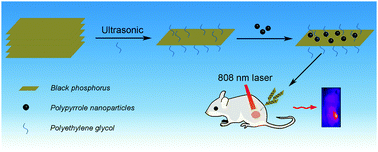Black phosphorus–polypyrrole nanocomposites for high-performance photothermal cancer therapy†
Abstract
The favorable biocompatibility, biodegradability and broadband absorption in the ultraviolet to near-infrared (NIR) region have made black phosphorus (BP) a new generation two-dimensional nanomaterial with great potential for photothermal therapy (PTT). However, an appropriate but not low dosage of nanoagent is required to achieve the satisfactory therapeutic effect in BP-based NIR PTT, due to the decreasing light absorption of BP in the NIR region. In this work, nanohybrids composed of BP nanosheets and several polypyrrole (PPy) nanoparticles attached to them (BP/PPy NSs) are fabricated for high-performance NIR PTT, benefiting from the superimposed NIR absorption characteristics of the two components. The nanocomposites exhibit irregular, speckled and flake-like morphologies with good biocompatibility and superior NIR photothermal transduction efficiency compared with that of the bare nanosheets. The utilization of BP/PPy NSs as novel nanotherapeutic agent for enhanced NIR photothermal cancer therapy is accomplished in vitro and in vivo.



 Please wait while we load your content...
Please wait while we load your content...